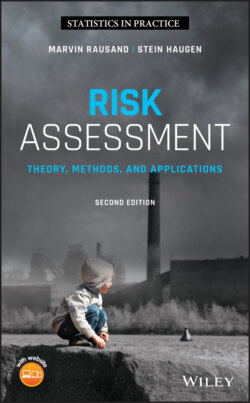Читать книгу Risk Assessment - Marvin Rausand - Страница 16
1.3 Major Accidents
ОглавлениеWhen used in risk research, a major accident is an accident with large and even catastrophic consequences. During the previous decades, a number of major accidents have made the public increasingly aware of the risk posed by certain technical systems and activities. A common denominator of these is that they not only have immediate effects in terms of loss of life, environmental damage, or economical effects but also long‐term effects by changing the public's and the authorities' attitudes toward the systems that have been involved in the accidents. A result of this is that changes in regulations often are made after major accidents. For companies involved, the consequences of these accidents not only incur enormous costs but may even force a company out of business and seriously damage the image of an entire industry. Examples of some past accidents with far‐reaching effects are listed in Table 1.1 . These accidents are representative of a large number of accidents that have served to remind us that safety can never be taken for granted. Macza (2008) discusses several of these accidents and the society's response to each accident with respect to legislation changes and other actions.
Table 1.1 Some past major accidents.
| Location of accident | Year | Consequences |
| North Atlantic | 1912 | Titanic colliding with an iceberg and sinking, 1500 killed. |
| Flixborough, UK | 1974 | Explosion and fire, 28 killed, more than 100 injured. |
| Seveso, Italy | 1976 | Dioxin release, 2000 poisoned, contamination of environment, mass evacuation. |
| North Sea, Norway | 1977 | Oil/gas blowout on Bravo platform, pollution of sea. |
| Three Mile Island, USA | 1979 | Nuclear accident. Limited actual consequences, but had potential for a major release of radiation. |
| Bhopal, India | 1984 | Release of toxic gas (MIC), 3800 killed, 500 000 exposed to gas. |
| Mexico City, Mexico | 1984 | Explosion and fire at LPG storage and distribution depot at San Juan Ixhautepec. Around 500 killed. |
| USA | 1986 | Explosion of Challenger space shuttle, 7 killed. |
| Chernobyl, Ukraine | 1986 | Explosion and atomic fallout at nuclear power station. |
| Basel, Switzerland | 1986 | Fire at Sandoz warehouse. Rhine River contaminated, severe environmental damage. |
| Zeebrügge, Belgium | 1987 | The car and passenger ferry Herald of Free Enterprise capsized, 193 killed. |
| North Sea, UK | 1988 | Explosion and fire on the Piper Alpha platform. Platform lost, 167 killed. |
| Alaska, USA | 1989 | Oil spill from tanker Exxon Valdez. Severe environmental damage. |
| Amsterdam, The Netherlands | 1992 | Boeing 747 cargo plane crashed near Schipol Airport, 43 killed. |
| Baltic Sea | 1994 | The car and passenger ferry Estonia capsized, claiming 852 lives. |
| Eschede, Germany | 1998 | High‐speed train derailed, 101 killed, 88 injured. |
| Longford Australia | 1998 | Explosion and fire, 2 killed, Melbourne without gas for 19 days. |
| Bretagne, France | 1999 | Loss of tanker Erika. Major oil spill. |
| Enschede, The Netherlands | 2000 | Explosion in fireworks plant. 22 killed, 1000 injured, more than 300 homes destroyed. |
| Toulouse, France | 2001 | Explosion and fire in fertilizer plant, 30 killed, 2000 injured, 600 homes destroyed. |
| Galicia, Spain | 2002 | Loss of tanker Prestige, major oil spill. |
| Texas City, USA | 2005 | Explosion and fire, 15 killed, 180 injured. |
| Hertfordshire, UK | 2005 | Explosion and fire at Buncefield Depot. |
| Gulf of Mexico | 2010 | Blowout and explosion on the drilling rig Deepwater Horizon, 11 killed, 17 injured, rig lost, major oil spill. |
| Fukushima Daiichi, Japan | 2011 | Release of radioactive material with widespread contamination. |
| Giglio, Italy | 2012 | Cruise ship Costa Concordia capsized, 32 killed. |
| Indonesia/Ethiopia | 2018/2019 | Two crashes with Boeing 737 MAX, with 189 and 157 fatalities, respectively. |
Many books give overviews of major accidents (Kletz 2001 ; Mannan 2012) and investigation reports are often published. In some cases, scientific books are also written about major accidents (e.g. see Hopkins 2000 ; Vaughan 1996).
